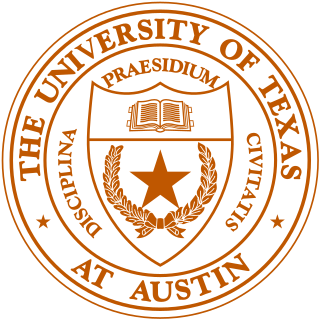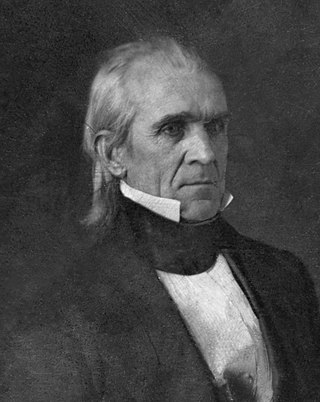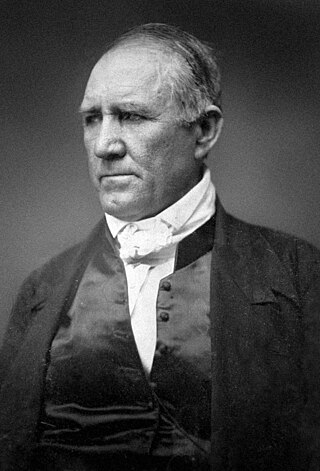Related Research Articles

Martin Van Buren was an American lawyer, diplomat, and statesman who served as the eighth president of the United States from 1837 to 1841. A primary founder of the Democratic Party, he served as New York's attorney general, U.S. senator, then briefly as the ninth governor of New York before joining Andrew Jackson's administration as the tenth United States secretary of state, minister to Great Britain, and ultimately the eighth vice president when named Jackson's running mate for the 1832 election. Van Buren won the presidency in 1836, lost re-election in 1840, and failed to win the Democratic nomination in 1844. Later in his life, Van Buren emerged as an elder statesman and an important anti-slavery leader who led the Free Soil Party ticket in the 1848 presidential election.

The Republic of Texas was a sovereign state in North America that existed from March 2, 1836, to February 19, 1846, that bordered Mexico, the Republic of the Rio Grande in 1840, and the United States of America, although Mexico considered it a rebellious province during its entire existence despite the Treaties of Velasco of May 1836. It was bordered by Mexico to the west and southwest, the Gulf of Mexico to the southeast, the two U.S. states of Louisiana and Arkansas to the east and northeast, and United States territories encompassing parts of the current U.S. states of Oklahoma, Kansas, Colorado, Wyoming, and New Mexico to the north and west. The Anglo residents of the area and of the republic became known as Texians.

The University of Texas at Austin is a public research university in Austin, Texas. It is the flagship institution of the University of Texas System. With 52,384 students as of Fall 2022, it is also the largest institution in the system.

The 1844 United States presidential election was the 15th quadrennial presidential election, held from Friday, November 1 to Wednesday, December 4, 1844. Democrat James K. Polk defeated Whig Henry Clay in a close contest turning on the controversial issues of slavery and the annexation of the Republic of Texas. This is the only election where both major party nominees served as Speaker of the House at one point, and the first where both candidates were not in an elected office at the time.

John Caldwell Calhoun was an American politician who served as the seventh vice president of the United States from 1825 to 1832. Born in South Carolina, he adamantly defended American slavery and sought to protect the interests of white Southerners. Calhoun began his political career as a nationalist, modernizer and proponent of a strong federal government and protective tariffs. In the late 1820s, his views changed radically, and he became a leading proponent of states' rights, limited government, nullification, and opposition to high tariffs. Calhoun saw Northern acceptance of those policies as a condition of the South's remaining in the Union. His beliefs and warnings heavily influenced the South's secession from the Union in 1860 and 1861. He was the first of two vice presidents to resign from the position, the other being Spiro Agnew, who resigned in 1973.

Samuel Houston was an American general and statesman who played an important role in the Texas Revolution. He served as the first and third president of the Republic of Texas and was one of the first two individuals to represent Texas in the United States Senate. He also served as the sixth governor of Tennessee and the seventh governor of Texas, the only individual to be elected governor of two different states in the United States.

The Texas annexation was the 1845 annexation of the Republic of Texas into the United States. Texas was admitted to the Union as the 28th state on December 29, 1845.

Austin College is a private liberal arts college affiliated with the Presbyterian Church (USA) and located in Sherman, Texas.

Abner Smith Lipscomb was an American and Texan lawyer and judge. He was also appointed Secretary of State for the Republic of Texas under the administration of President Mirabeau B. Lamar.

The Lyndon Baines Johnson Library and Museum, also known as the LBJ Presidential Library, is the presidential library and museum of Lyndon Baines Johnson, the 36th president of the United States (1963–1969). It is located on the grounds of the University of Texas at Austin, and is one of 13 presidential libraries administered by the National Archives and Records Administration. The LBJ Library houses 45 million pages of historical documents, including the papers of President Johnson and those of his close associates and others.

William Homer Thornberry was an American politician and judge. He served as the United States representative from the 10th congressional district of Texas from 1949 to 1963. From 1963 to 1965 he was a judge for the United States District Court for the Western District of Texas, and he was a judge for the United States Court of Appeals for the Fifth Circuit from 1965 to 1978.

Huston–Tillotson University (HT) is a private historically black university in Austin, Texas. Established in 1875, Huston–Tillotson University was the first institution of higher learning in Austin. The university is affiliated with the United Methodist Church, the United Church of Christ, and the United Negro College Fund. Huston–Tillotson University awards bachelor's degrees in business, education, the humanities, natural sciences, social sciences, science, and technology and a master's degree in educational leadership. The university also offers alternative teacher certification and academic programs for undergraduates interested in pursuing post-graduate degrees in law and medicine.
Events from the year 1829 in the United States.

Moses Waddel was an American educator and minister in antebellum Georgia and South Carolina. Famous as a teacher during his life, Moses Waddel was author of the bestselling book Memoirs of the Life of Miss Caroline Elizabeth Smelt.

Benjamin Harrison was an American politician who served as the 23rd president of the United States from 1889 to 1893. He was a member of the Harrison family of Virginia—a grandson of the ninth president, William Henry Harrison, and a great-grandson of Benjamin Harrison V, a Founding Father.

The presidency of Andrew Jackson began on March 4, 1829, when Andrew Jackson was inaugurated as President of the United States, and ended on March 4, 1837. Jackson, the seventh United States president, took office after defeating incumbent President John Quincy Adams in the bitterly contested 1828 presidential election. During the 1828 presidential campaign, Jackson founded the political force that coalesced into the Democratic Party during Jackson's presidency. Jackson won re-election in 1832, defeating National Republican candidate Henry Clay by a wide margin. He was succeeded by his hand-picked successor, Vice President Martin Van Buren, after Van Buren won the 1836 presidential election.

William Harry McRaven is a retired United States Navy four-star admiral who served as the ninth commander of the United States Special Operations Command (SOCOM) from August 8, 2011 to August 28, 2014. From 2015 to 2018, he was the chancellor of The University of Texas System.

Calhoun Hall is a building located on the University of Texas at Austin campus, built in 1968. The building is named after John William Calhoun, a mathematics professor, university comptroller from 1925 to 1937, and university president from 1937 to 1939.
References
- 1 2 Partheymuller, Peter (September–October 2001). "Written in Limestone". The Alcalde . Emmis Communications. 90 (1): 35. Retrieved March 27, 2011.
- ↑ "TSHA | Calhoun, John William".